Modern urban environments rely on sophisticated traffic signal systems that do far more than simply display red, yellow, and green lights. Today’s traffic signals are critical components of a smart transportation network, ensuring safety, optimizing traffic flow, and integrating with digital technologies. This comprehensive guide examines the evolution, design, and operation of traffic signals while incorporating the latest technical research from the FHWA Traffic Signal Timing Manual (Chapter 4). We explore system components, advanced phasing techniques, and the integration of detection systems—all vital to creating efficient and safe intersections.
Throughout the article, the term traffic signal is emphasized to maximize SEO and relevance. For those interested in advanced products, LEOTEK’s cutting‑edge solutions are highlighted with direct links to their product pages:
The Role of Traffic Signals
Traffic signals are the backbone of urban mobility, managing the movement of vehicles, pedestrians, and cyclists. Their primary functions include:
- Ensuring Safety: By providing clear and consistent instructions, traffic signals reduce conflicts at intersections and help prevent accidents.
- Optimizing Traffic Flow: Carefully timed signals minimize delays and reduce congestion, ensuring that vehicles and pedestrians move smoothly through intersections.
- Allocating Right-of-Way: Through the use of defined phases, traffic signals assign right-of‑way to various movements in a systematic and efficient manner.
- Enhancing Efficiency: Modern signals use adaptive control and real‑time data to adjust timings based on traffic demand, thereby making optimal use of roadway space.
As traffic volumes increase in urban areas, the need for advanced, efficient, and adaptive traffic signals becomes ever more critical.
Different Types of Traffic Signals
Traffic signals come in various types, each serving a specific function in controlling traffic movements:
Motor Vehicle Traffic Signals
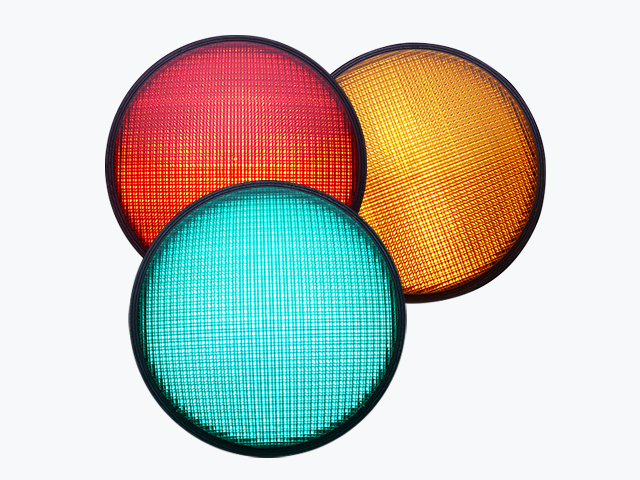
Motor vehicle traffic signals are the most widely recognized type. They typically consist of three circular lights that indicate:
- Red: Vehicles must stop.
- Green: Vehicles may proceed.
- Yellow: Signals an impending change from green to red, warning drivers to prepare to stop.
These signals regulate vehicle movements at intersections, ensuring safe and orderly flow.
Pedestrian Traffic Signals
Designed specifically for pedestrians, these signals help people cross roads safely. They often display:
- Red: Do not cross.
- Green: Safe to cross.
- Countdown Timers: Digital displays that indicate the remaining time for crossing.
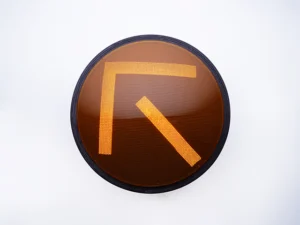
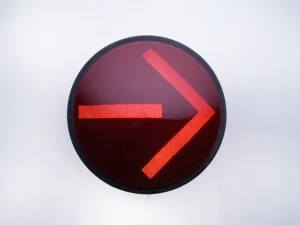

For more details on advanced pedestrian signal products, please visit LEOTEK’s Pedestrian Signal Solutions page.
Arrow Traffic Signals
Arrow traffic signals are used to control specific turning movements (e.g., left or right turns) at intersections. Instead of full circular indications, these signals use arrows to clearly indicate directional movements, reducing conflicts with other traffic streams.
Countdown Traffic Signals
Countdown traffic signals feature digital displays that show the remaining time in the current phase. These signals help drivers and pedestrians prepare for a change, improving intersection efficiency and reducing idling.
System Components in Traffic Signal Design
A modern traffic signal system is composed of several integrated components that work together to provide safe and efficient control at intersections. Recent FHWA research has provided enhanced insights into these components, which include detection systems, controllers, and communication networks.
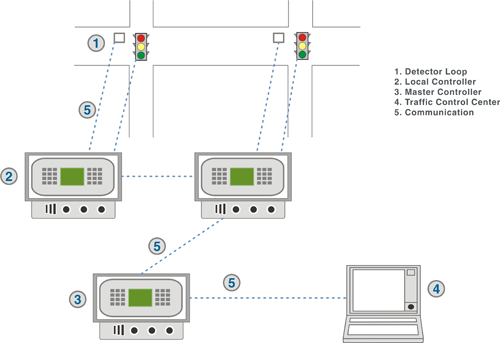
Detection and Local Control
Detection
Detectors—such as inductive loops, video sensors, or microwave sensors—are installed on approaches to capture real‑time data about vehicle and pedestrian presence. This information is critical for the controller to determine which phase to call and for how long.
- Enhanced Research Insight: The FHWA manual emphasizes that the detector layout must be “tuned” to the intersection’s geometry, traffic volume, and approach speed to optimize performance.
- Key Point: Effective detection minimizes delays and ensures that the system responds promptly to traffic conditions.
Local Controller
The local controller, typically housed in a cabinet adjacent to the intersection, processes signals from detectors and controls the signal heads accordingly.
- Functions: It implements phase timing, controls display transitions, and uses detector inputs to call for specific phases.
- Technical Detail: According to FHWA research, the local controller’s proper configuration is essential for converting detection “calls” into accurate timing intervals.
Master Controller, Traffic Control Center, and Communication
Master Controller
Some traffic signal systems include a master controller that coordinates multiple intersections. Its functions include selecting timing plans, aggregating detector counts, and monitoring overall system performance. Although optional, a master controller is essential for synchronized, corridor-wide operations.
Traffic Control Center
The Traffic Control Center serves as the operational hub where data from local controllers is collected, monitored, and analyzed. It enables real‑time adjustments to signal timing parameters and overall system coordination.
- Official Reference: More information can be found on the U.S. Department of Transportation’s website.
Communication
Wired or wireless communication channels connect the detectors, local controllers, master controller, and Traffic Control Center. This connectivity ensures that the entire system operates in harmony and can adapt quickly to real‑time conditions.
Understanding Signal Phasing and Operations
Signal phasing is the method by which a traffic signal allocates right-of‑way to different traffic movements. The FHWA Traffic Signal Timing Manual (Chapter 4) offers detailed technical guidance on phasing that enhances both safety and efficiency.
Definitions, Movements, and Intervals
What Is a Signal Phase?
A signal phase is defined as the complete sequence during which a specific movement or combination of movements is served. It comprises:
- Green Interval: When movement is allowed.
- Yellow (Change) Interval: A transitional period indicating that the signal will soon change.
- Red Clearance Interval: A safety interval ensuring that the intersection is cleared before conflicting movements are allowed.
The MUTCD defines a signal phase as including the right‑of‑way, yellow change, and red clearance intervals assigned to one or more traffic movements.
Movements and Intervals
- Movement: Describes the user action, such as a vehicle turning or a pedestrian crossing.
- Interval: The duration during which the signal indication remains constant (e.g., the “Walk” interval in a pedestrian phase).
Ring-and-Barrier Diagrams
Ring-and-barrier diagrams are essential for visualizing how phases are coordinated within an intersection:
- Rings: Group phases that operate sequentially. For example, in an eight‑phase controller, phases 1–4 might form one ring and phases 5–8 the second.
- Barriers: Represent synchronization points where conflicting movements must be separated by a clear interval.
- Phase Pairs: Phases within the same ring and barrier that cannot be displayed simultaneously and must end concurrently.
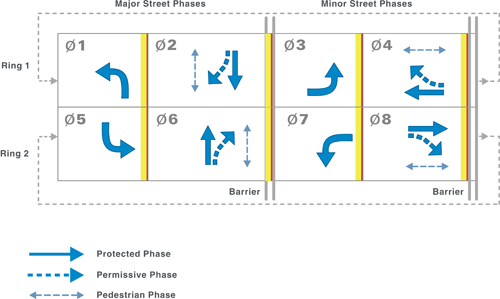
Enhanced Detail: FHWA Chapter 4.2 provides detailed examples and rules for constructing these diagrams, ensuring that conflicting movements are adequately separated to maintain safety.
Phasing Options and Left-Turn Display Strategies
The FHWA manual outlines various strategies for handling left-turn movements, which are crucial for optimizing intersection performance:
- Permissive Only Left-Turn Phasing: Left-turn vehicles turn concurrently with through traffic, relying on drivers to yield.
- Protected Only Left-Turn Phasing: Left-turns are served exclusively with a green arrow, enhancing safety at the expense of added cycle time.
- Protected-Permissive Left-Turn Phasing: Combines both approaches to provide flexibility and balance between safety and efficiency.
- Split Phasing: Separates movements on one approach from those on the opposing approach, useful when lane geometry or volumes dictate separate handling.
- Prohibition of Left Turns: In some cases, left turns are entirely prohibited during certain times to reduce conflicts.
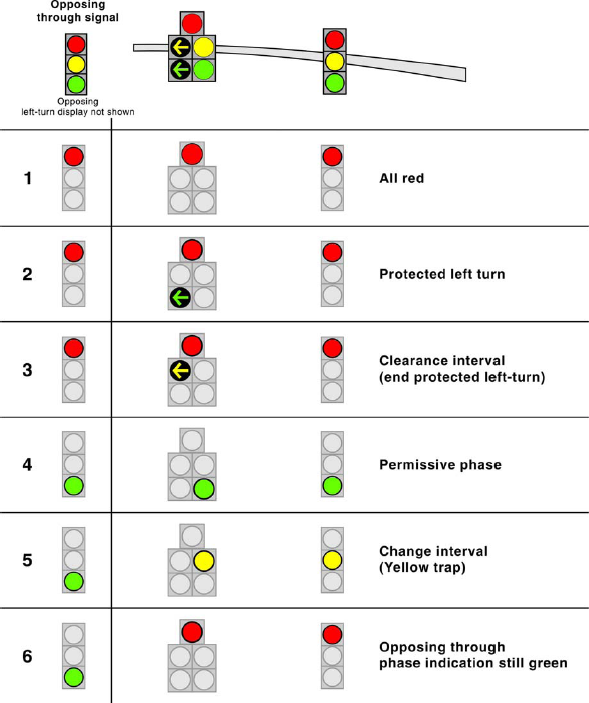
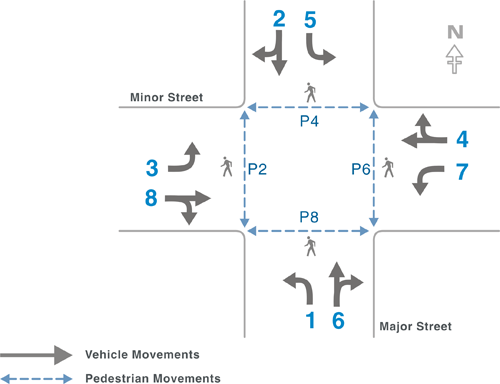
Additional details—including issues like the “yellow trap” and solutions such as the flashing yellow arrow or “Dallas Display”—are discussed in FHWA Chapter 4.3.
Advanced Phasing Sequences
Advanced sequencing options provide further refinement:
- Lead-Lead Left-Turn Phase Sequence: Both opposing left-turn movements start simultaneously.
- Lag-Lag Left-Turn Phase Sequence: Left-turn phases start later, which can help mitigate the “yellow trap.”
- Lead-Lag Left-Turn Phase Sequence: One phase leads while the other lags, allowing flexibility for coordinating through movements.
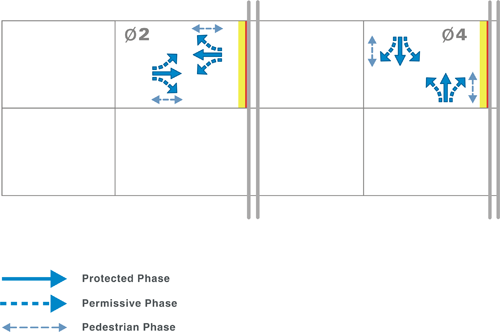
FHWA Chapter 4.4 discusses these sequences in detail, emphasizing their impact on overall cycle efficiency and safety.
Integration of Detection with Phasing
Effective signal phasing is closely linked with detection:
- High-Speed Approaches: Multiple detectors are placed upstream to manage the “indecision zone” (or “dilemma zone”), ensuring drivers have adequate time to decide whether to stop or proceed.
- Low-Speed Approaches: A stop bar detector may be sufficient to call the phase and clear the queue.
- Tuning: The detector layout must be carefully tuned to the intersection geometry and traffic characteristics to maximize efficiency.
FHWA Chapters 4.7 and 4.8 provide comprehensive guidelines on how detection systems are integrated with signal timing to optimize phase performance.
Additional Government References on Signal Phasing
For further technical details on signal phasing, consult these official resources:
- Federal Highway Administration – Manual on Uniform Traffic Control Devices (MUTCD): MUTCD Website
- Federal Highway Administration – Traffic Control Devices Handbook: FHWA Traffic Control Devices Handbook
- U.S. Department of Transportation: U.S. DOT Website
These resources offer authoritative guidance that complements the FHWA research described above.
Traffic Signals at a Typical Intersection
Understanding how traffic signals are deployed at intersections is key to comprehending their overall impact on traffic management.
Intersection Layout and Signal Placement
At a typical four‑leg intersection:
- Motor Vehicle Signals: Installed on each approach, these consist of three‑color signal heads controlling vehicular movement.
- Pedestrian Signals: Located at crosswalks, these signals ensure safe pedestrian crossings.
- Countdown Timers: Digital displays that indicate the remaining time in the current phase help manage driver and pedestrian expectations.
For more advanced traffic signal products, visit LEOTEK’s Traffic Signal Solutions page.
How Traffic Signals Work in Practice
The operation of a traffic signal at an intersection involves several coordinated steps:
- Data Collection: Detectors sense the presence of vehicles and pedestrians.
- Phase Activation: The controller selects and activates the appropriate phase based on predetermined timing or adaptive algorithms.
- Dynamic Adjustments: Real-time data is used to modify phase lengths, ensuring that traffic flows efficiently.
- Safety Measures: Yellow intervals and countdown timers provide crucial warnings, reducing the risk of collisions.
This orchestration maximizes throughput while ensuring that all road users receive clear, unambiguous instructions.
Technology and Innovation in Traffic Signals
Advancements in technology have transformed traditional traffic signals into sophisticated, smart systems.
LED Technology and Energy Efficiency
LEDs are now the standard for traffic signals due to their numerous advantages:
- Extended Lifespan: LEDs offer tens of thousands of hours of operation, reducing maintenance costs.
- Lower Energy Consumption: They use significantly less energy than incandescent bulbs, lowering operating costs and reducing carbon emissions.
- Enhanced Visibility: LEDs provide bright, uniform illumination even under adverse weather conditions.
- Robust Durability: Their design makes them resistant to shock and vibration, ideal for outdoor use.
Digital and IoT Integration
The integration of digital control systems and the Internet of Things (IoT) has revolutionized traffic signal operation:
- Real-Time Monitoring: Digital controllers enable continuous oversight and remote management.
- Adaptive Signal Control: IoT-enabled signals adjust timings dynamically based on live traffic data.
- Data Analytics: Sensors collect data that informs future traffic planning and real-time adjustments.
- System Integration: Traffic signals are now integrated into broader smart city networks, coordinating with public transit, emergency services, and environmental monitoring.
Smart Traffic Signals and the Future
The next generation of traffic signals is “smart” and leverages advanced technologies:
- Artificial Intelligence (AI): AI algorithms optimize signal timing by analyzing historical and real‑time data.
- Vehicle-to-Infrastructure (V2I) Communication: Smart signals communicate with connected vehicles to provide real‑time updates, improving traffic flow.
- Sustainability Initiatives: Integration with renewable energy sources, such as solar panels, further enhances environmental sustainability.
- Enhanced User Interfaces: Improved interfaces provide better feedback for drivers and pedestrians.
These innovations promise to create a future of safer, more efficient, and environmentally sustainable urban transportation.
Economic, Environmental, and Safety Impacts
Modern traffic signals offer significant benefits that extend across economic, environmental, and safety domains.
Economic Benefits
- Lower Energy Costs: Energy-efficient LED technology and adaptive controls result in lower operational expenses.
- Reduced Maintenance Expenses: Longer-lasting components and predictive maintenance reduce repair and replacement costs.
- Improved Traffic Flow: Optimized signal timing reduces delays, saving time for commuters and boosting overall productivity.
- Enhanced Urban Appeal: Efficient and well-managed intersections contribute to higher property values and attract investment.
Environmental Benefits
- Reduced Carbon Emissions: Lower energy consumption translates to a smaller carbon footprint.
- Minimized Light Pollution: Advanced design minimizes excessive illumination, preserving the natural night environment.
- Support for Renewable Energy: Integration with renewable energy sources further reduces reliance on non‑renewable power.
Safety Improvements
- Accident Reduction: Clear and adaptive signal indications significantly reduce the risk of collisions.
- Enhanced Pedestrian Protection: Dedicated pedestrian phases and countdown timers improve crosswalk safety.
- Faster Emergency Response: Adaptive signal control facilitates quicker phase changes during emergencies, helping first responders navigate intersections more safely.
LEOTEK Acquisition and Strategic Transformation
In a significant industry development, LEOTEK—a San Jose, Calif.-based traffic IoT operation service provider—has acquired the traffic business of Dialight, a renowned global leader in LED industrial lighting. Announced on July 31, 2024, this acquisition marks a strategic milestone that further cements LEOTEK’s position in the global smart transportation sector.
Strategic Significance
LEOTEK President Torrent Chin stated:
“This acquisition represents LEOTEK’s strategic layout in the global smart transportation sector. From traffic signal system management, roadway lighting, and traffic monitoring to electric vehicle charging stations and AI Roadway Management, we will persist in investing in the development and integration of AI intelligent transportation operation technology, offering safe, ecological, and low‑carbon transportation services to enhance urban infrastructure and operational efficiency.”
Market Expansion and Leadership
Already a dominant force in North America, LEOTEK is poised to become a global pioneer in digital traffic signal services through this acquisition. With operations in over 30 countries and partnerships with thousands of public and private transportation entities, LEOTEK is aggressively upgrading traffic systems in major cities throughout the Americas.
Technological Integration
Dialight, with a legacy dating back to 1938, has been a leading supplier of ITE‑compliant traffic signal lights. The integration of Dialight’s products with LEOTEK’s advanced, AI‑IoT‑enabled solutions significantly enhances the overall quality and reliability of traffic signal systems. LEOTEK incorporates intelligent sensors into visible signals and leverages big data through its Roadway Management System to enable effective vehicle-to‑infrastructure (V2I) networking services.
Future Goals
LEOTEK aims to deepen its technical integration so that its AI intelligent transportation services can reduce energy consumption by 50%, lower operating costs by 30%, and cut carbon emissions by 30%. This acquisition is a key driver of the “Roadway Intellimation” transformation, pushing the industry toward digital and sustainable transportation solutions.
For more information on advanced traffic signal products, visit LEOTEK’s Traffic Signal Solutions page.
Summary and Key Takeaways
This comprehensive guide has examined the evolution, design, and operation of traffic signals—from historical beginnings to the latest technological innovations. Key points include:
- Historical Evolution: Traffic signals have advanced from simple oil lamps to sophisticated LED‑based, IoT‑enabled systems.
- Types of Signals: Motor vehicle, pedestrian, arrow, and countdown signals each play a crucial role in managing traffic.
- System Components: The integration of detection, local controllers, master controllers, and communication networks is essential for effective traffic signal operation.
- Signal Phasing: Detailed phasing strategies—including definitions, ring-and-barrier diagrams, and advanced left-turn sequences—ensure that intersections operate safely and efficiently.
- Integration of Detection with Phasing: A robust detection system is vital to accurately call and terminate phases, particularly on high-speed approaches.
- Technological Advances: LED technology, digital controls, and IoT integration are transforming traffic signals into smart, adaptive systems.
- Strategic Developments: LEOTEK’s acquisition of Dialight’s traffic business represents a significant step toward digital, sustainable transportation.
- Impacts: Modern traffic signals deliver economic savings, environmental benefits, and enhanced safety for all road users.
Further Information and LEOTEK Solutions
For urban planners, traffic engineers, and municipalities seeking advanced traffic management solutions, LEOTEK offers a comprehensive range of innovative products. Their portfolio includes state‑of‑the‑art LED traffic signals, integrated digital controllers, and specialized pedestrian signals—all engineered to optimize intersection performance and enhance urban safety.
Learn more about LEOTEK’s cutting‑edge solutions by visiting:
By choosing LEOTEK’s advanced products, you can transform your city’s traffic control system into a smart, efficient, and sustainable network that meets the demands of modern urban living.
References (APA Format)
- AEC Illuminazione. (n.d.). Smart street lighting systems | Smart city lighting. Retrieved from https://aecilluminazione.com/smart-street-lighting-system/
- Cities Today. (n.d.). The rise of super smart streetlights. Retrieved from https://cities-today.com/the-rise-of-super-smart-streetlights/
- DC Smart Street Lights. (n.d.). Retrieved from https://streetlights.dc.gov/
- Federal Highway Administration. (n.d.). Manual on Uniform Traffic Control Devices (MUTCD). Retrieved from https://mutcd.fhwa.dot.gov/
- Federal Highway Administration. (n.d.). Traffic Control Devices Handbook. Retrieved from https://ops.fhwa.dot.gov/publications/fhwahop16058/
- Global Lighting Forum. (n.d.). Top smart street lighting companies. Retrieved from https://shine.lighting/threads/top-smart-street-lighting-companies.56/
- Itron. (n.d.). Intelligent streetlights | Smart cities. Retrieved from https://itron.com/na/solutions/what-we-enable/smart-cities/intelligent-streetlights
- New York Power Authority. (n.d.). Smart street lighting NY. Retrieved from https://nypa.gov/services/clean-energy-solutions/smart-street-lighting-ny
- Sensus. (n.d.). Smart street lighting. Retrieved from https://sensus.com/smart-utility-network/smart-lighting/
- TechTarget. (n.d.). What is a smart streetlight? Retrieved from https://techtarget.com/iotagenda/definition/smart-streetlight
- U.S. Department of Transportation. (n.d.). Transportation Topics. Retrieved from https://www.transportation.gov/
- Verizon. (n.d.). Intelligent lighting: Smart street lighting. Retrieved from https://verizon.com/business/products/internet-of-things/connected-smart-cities-communities/intelligent-lighting/
- Verizon Business. (n.d.). How smart street lights can deter crime and improve safety in cities. Retrieved from https://verizon.com/business/resources/articles/s/how-smart-street-lights-can-help-deter-crime-and-improve-safety-in-cities/
Conclusion and Call-to-Action
Traffic signals are far more than simple light fixtures—they are complex, dynamic systems that form the backbone of urban transportation. The evolution from conventional systems to modern, smart, LED‑based, IoT‑enabled traffic signals has transformed how cities manage intersections, reduce congestion, and enhance safety for drivers and pedestrians alike.
By incorporating advanced system components and sophisticated phasing strategies—as detailed by the FHWA and integrated throughout this guide—urban planners can ensure that intersections operate safely, efficiently, and sustainably. Moreover, strategic innovations such as LEOTEK’s recent acquisition of Dialight’s traffic business signal a significant shift toward digital and sustainable transportation solutions.
Take the next step toward transforming your urban landscape. Explore LEOTEK’s innovative traffic signal solutions by visiting their Traffic Signal Solutions and Pedestrian Signal Solutions pages today. Embrace the future of urban mobility with cutting‑edge technology that drives progress, enhances safety, and supports a sustainable, low‑carbon future.
This comprehensive guide is intended for urban planners, traffic engineers, policymakers, and anyone interested in the technical and operational aspects of modern traffic control systems. By integrating historical insights with the latest FHWA research and advanced design strategies, we provide a robust framework for planning and implementing state‑of‑the‑art traffic signal solutions in your community.
Author
-
Johnny Wu
Specializing in SEO and digital marketing with a passion for enhancing online visibility. With over a year in the IoT industry, I focus on advancing roadway IoT and AI technologies to improve traffic management and road safety.

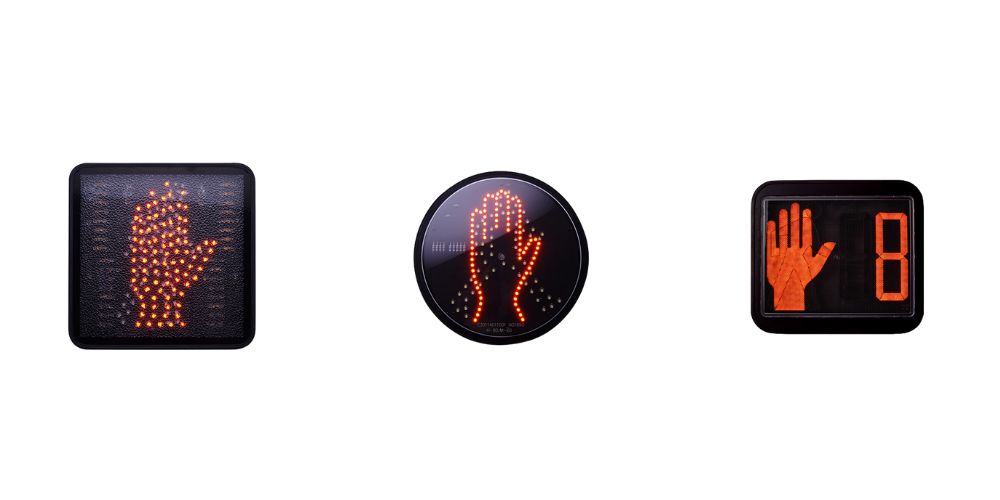


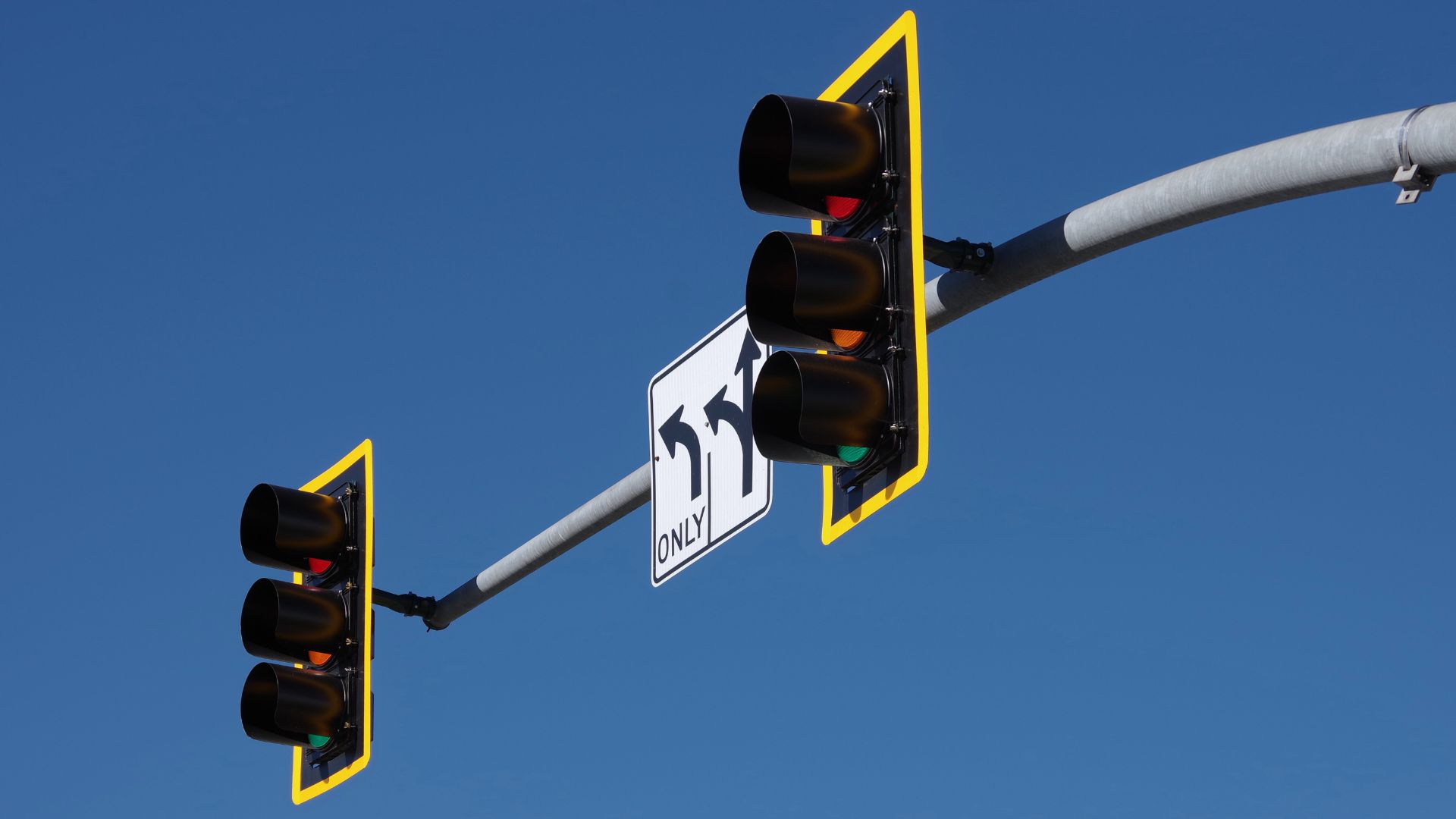
-.jpg)
